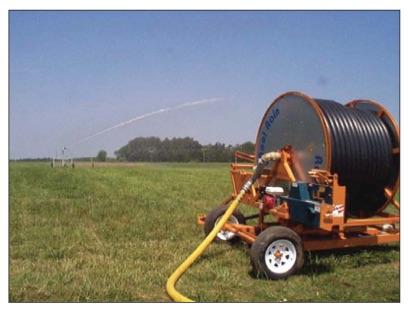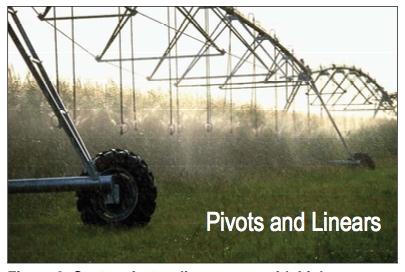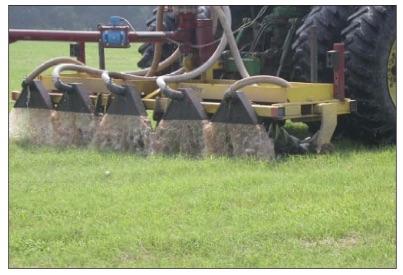Introduction
In North Carolina, wastewater from a variety of sources is land-applied to recover its beneficial components. Nitrogen (N), phosphorus, potassium, organic matter, calcium, magnesium, manganese, copper, and zinc, as well as the water itself, are all beneficially used for crop production. Wastewater can be land-applied using a variety of techniques. Spray irrigation, a common method, can release odor-causing gases or cause drift of fine droplets that transport odor-causing gases.
Another related undesirable issue is the loss of gaseous ammonia (NH3) during wastewater application. Ammonia in the soil readily converts to plant-available N forms, ammonium (NH4+), and nitrate (NO3-). One thousand gallons of anaerobic hog lagoon effluent contain about 4 to 6 pounds of total N. Irrigation of anaerobic hog lagoon effluent can result in loss of one-third to one-half of the applied N through ammonia volatilization (Balla 2007). Although some organic gases in wastewater are likely the predominant cause of odor, ammonia is a pungent gas that can also contribute to odor during land application. Loss of ammonia reduces the fertilizer value of the effluent. Ammonia losses can adversely affect public health and the environment, so methods of reducing ammonia loss during application can help reduce losses of other odorous gases and mitigate the impacts.
This publication addresses application techniques that affect drift and odor problems associated with wastewater application. The information can help managers and designers of land application systems make wise decisions on how to apply wastewater with minimal impact on neighbors and the environment. This publication also explains the mechanics of odor loss from a wastewater application system and offers guidance to reduce odor losses.
Regulations
North Carolina requires permits for the land application of all types of wastewater — agricultural, municipal, and industrial. Confined livestock farms exceeding a certain size (for example, 250 or more pigs) that use liquid waste management and nondischarge methods of waste disposal are covered by the Waste Management System General Permit (NC EMC-DEQ 2019). The General Permit does not allow wastewater to reach surface waters or wetlands as runoff or drift. However, under certain circumstances, farms that are eligible for coverage under the General Permit may be required to apply for an individual permit. While there are no regulations on ammonia emissions from existing facilities, North Carolina regulations limit ammonia emissions from new or expanding swine farms using liquid waste management to an annual average of 0.9 lb of ammonia-N per week per 1,000 lb of steady state live weight (SSLW), which includes an annual average of 0.2 lb ammonia-N per week per 1,000 lb SSLW from land application (North Carolina Administrative Code 15A NCAC 02T.1307, 2018). Odor regulations that apply only to permit conditions that deal with odor are usually general in nature and state that the manager should control objectionable odors and not cause a public nuisance. Regulatory actions regarding odor are complaint-driven, requiring an on-site assessment if siting requirements are not met (North Carolina Administrative Code 15A NCAC 02D .1802, 2000). If the state performs an on-site investigation and finds that the odor complaint is valid, a best management plan to reduce the likelihood of additional odor complaints will be required. The plan can include management decisions or changes in equipment, or a combination of both. More detail on these options follows. However, new or modified swine farms, built to increase SSLW after February 28, 1999, are required to meet numerical odor thresholds (North Carolina Administrative Code 15A NCAC 02D.1808, 2019). All facilities regulated under the state General Permits (swine, wet poultry, and cattle) must complete an Odor Control Checklist and keep a copy on file. Once an odor control measure is indicated on the Odor Control Checklist, it becomes part of the operator’s permit. Therefore, only measures currently in place should be indicated on the checklist, and new checklists should be filled out upon addition of any odor control measure.
Factors That Affect Drift and Odor
All types of wastewater, regardless of degree of treatment, contain some odorous compounds. Odor is generated during wastewater application when dissolved odorous gases are released into the air or when fine effluent droplets evaporate, releasing the dissolved gases into the atmosphere.
Drift and odor during land application are affected by several factors. Physical or landscape features, such as windbreaks, can reduce drift and odor. Wastewater properties, such as total solids and pH, can also affect odor. Soil properties, such as soil texture and cation exchange capacity (CEC), can also affect odors. Application and weather factors that affect drift and odor include:
- discharge pressure of the land application equipment,
- nozzle size and type,
- droplet size from the land application equipment,
- contact time between wastewater stream and air, and
- weather conditions.
Discharge pressure: As discharge pressure increases, droplet size decreases, leading to greater odor and drift.
Nozzle size and type: As nozzle size increases, droplet size will also increase. However, nozzles can operate at a range of pressures, and droplet size decreases as the pressure is increased. The nozzle type has a big influence on droplet size: The ring nozzle breaks up droplets the most, whereas the taper bore nozzle gives the biggest droplets for the same orifice size and operating pressure. The taper ring nozzle is intermediate between the ring and taper bore nozzles in droplet size.
Droplet size: Droplet size is governed by operating pressure, nozzle size, and nozzle type. As the droplet size increases, the potential for odor loss decreases since a lower fraction of the dissolved odorous gases is released into the air. Similarly, increasing droplet size leads to lower drift since the heavier droplets are less likely to be transported off-site by the wind. Hence, application systems that create finer droplets increase the potential for drift and odor movement. Some systems apply wastewater in a “flooding” pattern, such as the hose-drag system (Figure 3), with which there are fewer individual droplets leading to reduced odor and drift.
Contact time between wastewater stream and air: To obtain greater wetted area coverage, irrigation systems discharge wastewater relatively high above the ground surface and at angles up to 45 degrees above the horizontal. Due to the height and angle of discharge, dissolved gases in the wastewater have more time to be released to the air. Higher operating pressures required for such equipment cause formation of smaller droplets that further increase odor losses and drift compared with wastewater released closer to the ground and at lower pressures. Drift and odorous gas release are further increased by wind speeds that increase with height above the ground.
Weather conditions: Weather parameters that affect drift and odor include wind speed and direction, temperature, relative humidity, and atmospheric stability. These parameters interact in a complicated way with one another and may have opposite effects on drift and odor. Higher wind speeds increase drift; however, they dissipate odor. It is not advisable to apply wastewater using sprinkler irrigation methods when the wind direction can transport drift toward neighbors’ houses or streams. Drift increases in warm and dry (low relative humidity) weather because the droplets lose moisture faster while moving through the air and can be transported farther. Although warm temperatures increase the activity of odor-causing bacteria, land application in warm weather will result in faster dissipation of odor due to greater turbulence. Increased relative humidity also increases the perception of odor.
The atmosphere is stable when the air close to the ground is colder and heavier than the air above it. This usually happens during early morning, evening, and through nighttime, when winds are lower. Land application under stable conditions will trap odors close to the earth and spread them sideways, affecting neighbors. However, drift is reduced under such conditions due to low wind, cool temperature, and high relative humidity. As the sun heats the ground, the warmed air rises upward, causing mixing, thus creating unstable conditions. Unstable conditions may cause more drift, but less odor, because of better dissipation of gases.
Environmental conditions can affect drift and odor in different ways, making management difficult. It is generally recommended that spray application of wastewater should be done under low wind conditions (less than 5 mph) and after mid-morning, preferably in bright sunshine.
Selection Considerations
Several factors should be assessed when determining what type of wastewater application equipment is best for a given situation. Some of the options listed in Table 1 offer excellent control of drift and odor, but they may be impractical where large volumes of wastewater must be handled. The need for odor and drift control must be balanced with equipment costs and management requirements.
The need for odor and drift control may require a field-by-field decision because it is related to the area where wastewater application occurs. Are there neighbors nearby? Is the site close to high-impact areas that have large numbers of people, not necessarily at once but continually (for example, historic sites, parks, or hospitals)? Have there been complaints and, if so, what is the frequency of these complaints? If complaints or regulatory pressure have been low, then simple solutions such as proper irrigation timing or a vegetative windbreak may be all that are needed.
Any type of management strategy that affects the type of crop or tillage must complement the farm's existing erosion-control plan and animal waste management plan. Further, soil incorporation may have limited value, as drift and odor can occur during application. Incorporation immediately after application can better control odor than allowing a waste product with persistent odors to remain on the surface. Most irrigated wastewater will soak into the soil and usually not result in persistent residual odor. In taller vegetation, odor may persist longer than on bare soil, because as the liquid intercepted by the vegetation evaporates, odorous gases are released. Wastewater with higher solids content can present persistent odor problems. For those materials, soil incorporation in coordination with the animal waste management plan may be a good odor control measure.
There are many factors to assess when selecting wastewater application methods. Along with odor and drift, you must consider cost, ease of operation, applicability to the site, and maintenance requirements. Table 2 gives some general guidance for various land application systems. The system types listed in Table 2 are not exactly parallel to those in Table 1. Table 2 defines the systems by category, without focus on the specific nozzle or sprinkler types that can be used with each system.
| Platform | Operation Type | Description | Potential for Drift | Potential for Odor |
|---|---|---|---|---|
| Big Gun | Stationary | A sprinkler with a large-bore nozzle, 0.5 inch to 2.0 inches in diameter. Typical operating pressure is 60 – 130 pounds per square inch (psi). Generally, height above ground surface is 4 to 6 feet. | High | High |
| Traveling (Figure 1) | A sprinkler with a large-bore nozzle, 0.5 inch to 2.0 inches in diameter. Typical operating pressure is 60 – 130 psi. Generally, height above ground surface is 4 to 6 feet. | High | High | |
| Center Pivot/Linear Move | End Gun | A sprinkler with a large-bore nozzle, 0.5 inches to 2.0 inches in diameter. Typical operating pressure is 60 – 130 psi. Typical height above ground surface is 10 to 12 feet. | High | High |
| Overhead Nozzle (Figure 2) | A sprinkler with a small-bore nozzle, generally 1⁄8 inch to 3⁄8 inch in diameter. Typical operating pressure is 25 – 60 psi. Typical height above ground surface is 10 to 12 feet. | Moderately high to high (height dependent) | High | |
| Low Drift Drop Nozzle | A specialized drop nozzle designed to create a stream of liquid and minimize the fine droplets that are prone to drift. Typical operating pressure is 5 – 20 psi. Typical height above ground surface is 3 to 6 feet. | Low to moderate | Low | |
| Mobile Drip Irrigation | Drip tape is pulled along the ground by the pivot or linear move system with discharge at ground level using low pressure (5 – 15 psi). | Very low | Low | |
| Solid Set | Impact sprinklers with nozzles operating at 40 – 60 psi on risers. | Moderately high to high | Moderately high to high | |
| Hose Drag | Surface Broadcast (Figure 3) | A device or opening designed for a large volume discharge at a very low pressure (less than 5 psi). These nozzles are typically 2 inches or larger, with a swath width usually less than 10 feet. | Very low | Very low |
| Injection | Application method identical to surface broadcast (above) except knives create slits or holes in the soil to reduce surface pooling. | Very low to none | Very low | |
| Boom Applicator | Drop Nozzle | A nozzle typically attached to a drop hose with a pressure regulator to allow liquid discharge close to the ground. Typical operating pressure is 25 – 50 psi. However, low elevation spray application (LESA) and low elevation precision application (LEPA) can operate as low as 6 psi. Space between applicators will vary with nozzle height, size, and pressure. | Low to moderate | Low |
| Low Drift Drop Nozzle | A specialized drop nozzle designed to create a stream of water and minimize the fine droplets that are prone to drift. Typical operating pressure is 5 – 20 psi. | Very low | Very low | |
| Large Diameter, Low Pressure Discharge Hose | These use a large diameter, low pressure nozzle at ground level for water distribution. Typical operating pressure is less than 10 psi. | Very low | Very low | |
| Tanker Wagon | Surface Application | These are liquid tankers that also use a large diameter, low pressure nozzle for water distribution. Typical operating pressure is less than 10 psi. | Very low to low | Low |
| Injection | Application method like surface application except knives create slits or holes that minimize surface pooling. | Very low to none | Very low | |
| Platform | Operation Type | Capital Cost | Operating Costs | Applicability to the Site | Maintenance Requirements | Comments |
|---|---|---|---|---|---|---|
| Big Gun | Stationary | Moderate | Low | Not suited to small fields or fields with low infiltration rates. | Moderate | |
| Traveling (Figure 1) | Moderate | Moderate | Suited to medium to large fields. Not suited to sloping or irregularly shaped land. | Moderate | Mobile; easy to add additional acres. | |
| Center Pivot / Linear Move | End Gun | Low | Low | Suited to large fields only. Not suited to sloping or irregularly shaped land. | Moderate | Per acre cost decreases as field size increases. Small nozzles are prone to clogging. |
| Overhead Nozzle (Figure 2) | Moderate to high | Low | ||||
| Low Drift Drop Nozzle | High | Low | ||||
| Mobile Drip Irrigation | High | Low | ||||
| Solid Set | Impact Sprinklers | High | Initial demand high | Suited to small or irregularly shaped fields. | Low | Operating cost is higher if the system has to be moved. Capital cost is higher for permanent installation. |
| Hose Drag | Surface Broadcast (Figure 3) | Moderate | High (requires full-time operator) | Applicable to a wide range of conditions. Possibly suitable for areas that cannot be covered by irrigation systems. | High (unit plus tractor) | Relative cost does not include tractor; assumes one of adequate size is available. |
| Injection | Moderate | |||||
| Boom Applicator | Drop Nozzle | Moderate | High (requires full-time operator) | Not suited to sloping or dissected land. | High (unit plus tractor) | Typically used in buffer or problem areas. It is not practical to move frequently to cover large areas. Small nozzles are prone to clogging with wastewater constituents. |
| Low Drift Drop Nozzle | ||||||
| Large Diameter, Low Pressure Discharge Hose | ||||||
| Tanker Wagon | Surface Application | High | High (requires a full-time operator) | Applicable to a wide range of conditions. Possibly suitable for areas that cannot be covered by irrigation systems. | High | Injection can increase operating cost by reducing application rate (acre/hour). |
| Injection | High |
Summary
Many factors affect the potential for drift and odor from a wastewater application system, as well as the potential for such drift to become a problem for the community or environment. Drift and odor are affected by application equipment choices such as equipment type, operating pressure, nozzle type and size, “add-on” choices, and discharge angle (and height). Weather factors such as wind speed affect both drift and odor; however, some weather factors that can increase drift (such as high temperature and low relative humidity) can reduce odor. An operator should evaluate both management and equipment factors to help with odor and drift control.
Acknowledgements
This publication is a revision of an earlier version. The authors would like to thank D. Crouse and K. Shaffer for their earlier contributions.
References
Balla, B. 2007. Determining Plant-Available Nitrogen in Hog Anaerobic Lagoon Effluent Applied with Traveling Gun and Drag Hose Systems. MS. Thesis. Raleigh, NC: NC State University.
Sheffield, R. Livestock and Poultry Environmental Stewardship Curriculum - Module D - Chapter 36.
Publication date: June 10, 2021
AG-439-69
N.C. Cooperative Extension prohibits discrimination and harassment regardless of age, color, disability, family and marital status, gender identity, national origin, political beliefs, race, religion, sex (including pregnancy), sexual orientation and veteran status.



